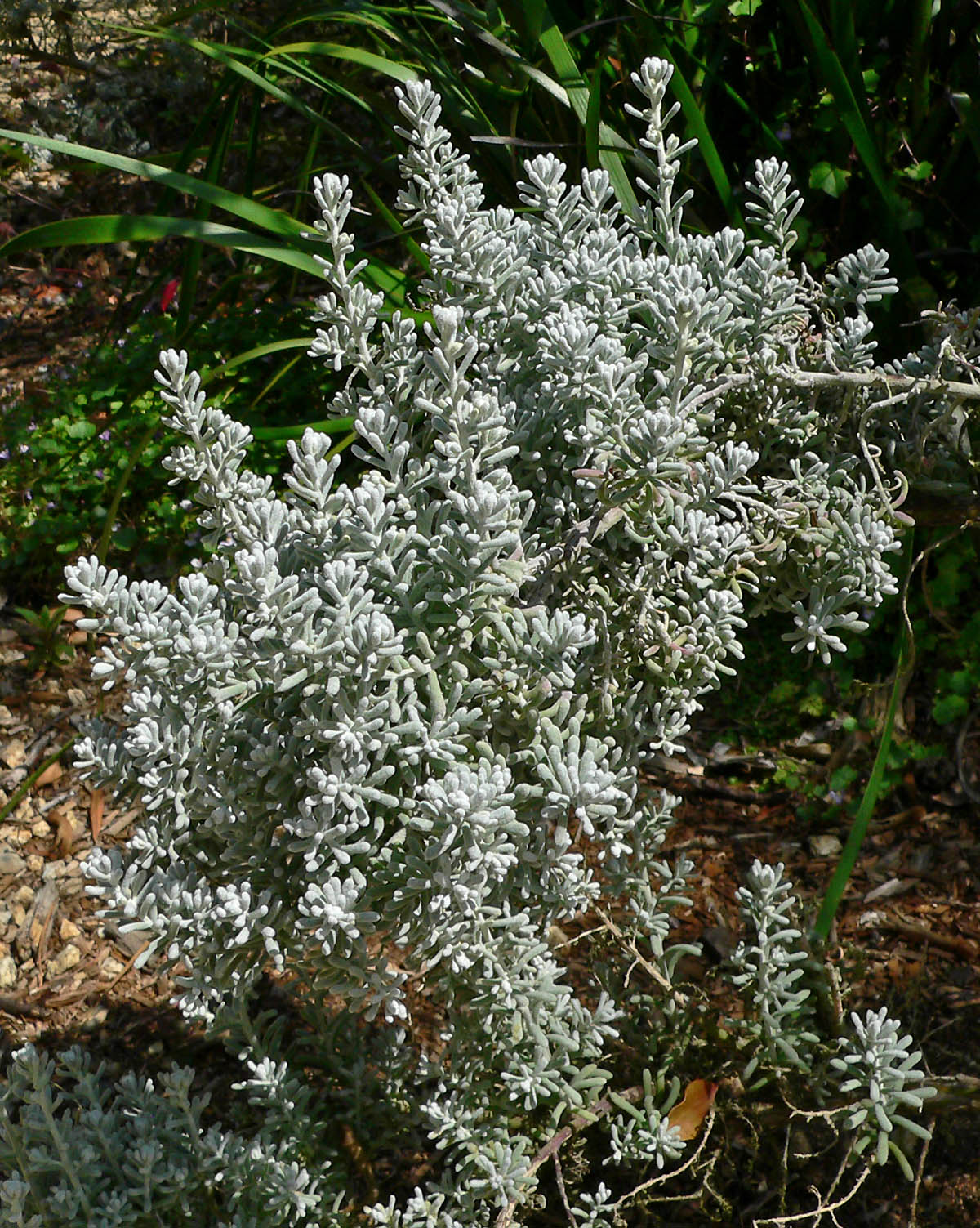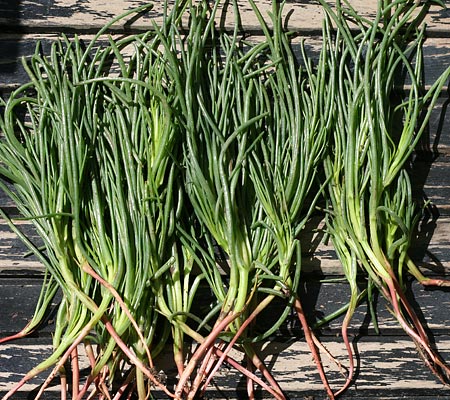|
Caroxyleae
The Salsoloideae are a subfamily of the Amaranthaceae, formerly in family Chenopodiaceae. Description These are herbs, subshrubs, shrubs and some trees. Stems and leaves are often succulent. The ovary contains a spiral embryo. In most genera, scarious wings develop at the outside of the fruiting perianth, allowing for dispersal by the wind ( anemochory). In tribe Caroxyleae, the stamens have vesiculose anther appendages, discolor with anthers, that probably play a role for insect pollination. In tribe Salsoleae the anther appendages are absent or small and inconspicuous. Distribution The area with most species (center of diversity) are the deserts and semideserts of Central-Asia and the Middle East. Distribution of the subfamily extends to the Mediterranean, to Middle-Europe, north and south Africa, and Australia, some species have also been introduced to America. Many species grow in dry habitats (xerophytes) or tolerate salty soils ( halophytes), some are ruderals. Pho ... [...More Info...] [...Related Items...] OR: [Wikipedia] [Google] [Baidu] |
Salsola Oppositifolia
''Salsola oppositifolia'' is a halophyte shrub native to the Mediterranean Basin. Description This annual, woody plant can grow into shrubs up to 2 m tall. It has cylindrical-linear and opposed leaves. The flowers, which bloom from May to October, are hermphrodyte and have a size of 1 cm. Taxonomy ''Salsola oppositifolia'' was first described by René Louiche Desfontaines and published in ''Flora Atlantica'' 1: 219. 1798. Uses This plant has been historically used, along with other Salsola species, as a source of soda ash Sodium carbonate, , (also known as washing soda, soda ash and soda crystals) is the inorganic compound with the formula Na2CO3 and its various hydrates. All forms are white, odourless, water-soluble salts that yield moderately alkaline solutions ..., in the manufacture of lye and soaps. References External links * * {{Taxonbar, from=Q6117491 Amaranthaceae Halophytes Industrial history Plants described in 1798 Barilla plants Flora of Alg ... [...More Info...] [...Related Items...] OR: [Wikipedia] [Google] [Baidu] |
Cornulaca Monacantha
''Cornulaca monacantha'' is a species of flowering plant in the genus '' Cornulaca'', that is now included in the family Amaranthaceae, (formerly Chenopodiaceae). It is a desert plant found in the Middle East and the Sahara, and the southern end of its range is considered to delineate the edge of the desert. In Arabic it is known as ''had'' and ''djouri'', and the Tuareg people call it ''tahara''. It was first described in 1813 by the French botanist Alire Raffeneau Delile. Description ''Cornulaca monacantha'' is a straggling, branched, woody shrub growing to a height of . The stubby bluish-green leaves are scale-like and clasp the greyish, wiry stems. They each have a single stiff spine at the tip, hence the specific name ''monacantha''. The leaves turn yellow or white when the plant is dead. The orange-brown flowers appear singly in the woolly leaf axils between August and November. The calyx and petals are spiny, the perianth lobes being linear and leathery, with jagged tip ... [...More Info...] [...Related Items...] OR: [Wikipedia] [Google] [Baidu] |
Kaviria
''Kaviria'' is a genus of flowering plants belonging to the family Amaranthaceae. Its native range is Somalia to Arabian Peninsula, Syria to Central Asia and Pakistan. Species: *''Kaviria aucheri'' *''Kaviria azaurena'' *''Kaviria gossypina'' *''Kaviria lachnantha'' *''Kaviria pycnophylla'' *''Kaviria rubescens'' *''Kaviria tomentosa'' *''Kaviria vvedenskyi'' *''Kaviria zehzadii'' References {{Taxonbar, from=Q5860388 Amaranthaceae Amaranthaceae genera ... [...More Info...] [...Related Items...] OR: [Wikipedia] [Google] [Baidu] |
Halocharis (plant)
''Halocharis'' is a genus of flowering plants belonging to the family Amaranthaceae. Its native range is Iraq to Central Asia and Pakistan, Arabian Peninsula. Species: *''Halocharis brachyura'' *''Halocharis clavata'' *''Halocharis hispida'' *''Halocharis lachnantha'' *''Halocharis sulphurea'' *''Halocharis violacea Halocharis may refer to: * ''Halocharis'' (plant), a genus of plants in the family Amaranthaceae * ''Halocharis'', a genus of wasps in the family Eulophidae, synonym of '' Closterocerus'' * ''Halocharis'', a genus of cnidarians in the family Zancl ...'' References {{Taxonbar, from=Q427585 Amaranthaceae Amaranthaceae genera ... [...More Info...] [...Related Items...] OR: [Wikipedia] [Google] [Baidu] |
Halimocnemis
''Halimocnemis'' is a genus of flowering plants belonging to the family Amaranthaceae. Its native range is Eastern Mediterranean to Xinjiang and Afghanistan. Species: *'' Halimocnemis azarbaijanensis'' *'' Halimocnemis beresinii'' *'' Halimocnemis glaberrima'' *'' Halimocnemis karelinii'' *'' Halimocnemis lasiantha'' *'' Halimocnemis latifolia'' *'' Halimocnemis longifolia'' *'' Halimocnemis macrantha'' *'' Halimocnemis mironovii'' *'' Halimocnemis mollissima'' *'' Halimocnemis occulta'' *'' Halimocnemis pedunculata'' *'' Halimocnemis pilifera'' *'' Halimocnemis sclerosperma'' *'' Halimocnemis smirnowii'' *''Halimocnemis villosa ''Halimocnemis'' is a genus of flowering plants belonging to the family Amaranthaceae. Its native range is Eastern Mediterranean to Xinjiang and Afghanistan. Species: *''Halimocnemis azarbaijanensis'' *''Halimocnemis beresinii'' *''Halimocnem ...'' References {{Taxonbar, from=Q9001887 Amaranthaceae Amaranthaceae genera ... [...More Info...] [...Related Items...] OR: [Wikipedia] [Google] [Baidu] |
Halarchon
''Halarchon'' is a genus of flowering plants belonging to the family Amaranthaceae Amaranthaceae is a family of flowering plants commonly known as the amaranth family, in reference to its type genus ''Amaranthus''. It includes the former goosefoot family Chenopodiaceae and contains about 165 genera and 2,040 species, making it .... Its native range is Afghanistan. Species: * ''Halarchon vesiculosus'' Bunge References {{Taxonbar, from=Q9001850 Amaranthaceae Amaranthaceae genera Taxa named by Alexander von Bunge ... [...More Info...] [...Related Items...] OR: [Wikipedia] [Google] [Baidu] |
Climacoptera (plant)
''Climacoptera'' is a genus of flowering plants belonging to the family Amaranthaceae Amaranthaceae is a family of flowering plants commonly known as the amaranth family, in reference to its type genus ''Amaranthus''. It includes the former goosefoot family Chenopodiaceae and contains about 165 genera and 2,040 species, making it .... Its native range is Temperate Asia. Species: *'' Climacoptera afghanica'' *'' Climacoptera amblyostegia'' *'' Climacoptera aralensis'' *'' Climacoptera botschantzevii'' *'' Climacoptera bucharica'' *'' Climacoptera canescens'' *'' Climacoptera chorassanica'' *'' Climacoptera crassa'' *'' Climacoptera czelekenica'' *'' Climacoptera ferganica'' *'' Climacoptera intricata'' *'' Climacoptera iranica'' *'' Climacoptera iraqensis'' *'' Climacoptera kasakorum'' *'' Climacoptera khalisica'' *'' Climacoptera korshinskyi'' *'' Climacoptera lachnophylla'' *'' Climacoptera lanata'' *'' Climacoptera longipistillata'' *'' Climacoptera lon ... [...More Info...] [...Related Items...] OR: [Wikipedia] [Google] [Baidu] |
Caroxylon
''Caroxylon'' is a genus of shrubby flowering plants in the family Amaranthaceae, found in drier areas of the Old World, including southern Africa, Madagascar, northern Africa, Mediterranean islands of Europe, the Canary Islands, Socotra, Ukraine, Russia, western Asia, Central Asia, India, western and northern China, and Mongolia. Species Currently accepted species include: *'' Caroxylon abarghuense'' (Assadi) Akhani & Roalson *''Caroxylon acocksii'' (Botsch.) Mucina *''Caroxylon adiscum'' (Botsch.) Mucina *'' Caroxylon adversariifolium'' (Botsch.) Mucina *''Caroxylon aegaeum'' (Rech.f.) Akhani & Roalson *'' Caroxylon aellenii'' (Botsch.) Mucina *'' Caroxylon agrigentinum'' (Guss.) C.Brullo, Brullo, Giusso, Guarino & Iamonico *'' Caroxylon albidum'' (Botsch.) Theodorova *'' Caroxylon albisepalum'' (Aellen) Mucina *''Caroxylon aphyllum'' (L.f.) Tzvelev *''Caroxylon apiciflorum'' (Botsch.) Mucina *'' Caroxylon apterygeum'' (Botsch.) Mucina *'' Caroxylon arabicum'' (Botsch.) Akhani ... [...More Info...] [...Related Items...] OR: [Wikipedia] [Google] [Baidu] |
Camphorosmoideae
Camphorosmeae is a species-rich tribe of the Amaranthaceae, formerly Chenopodiaceae, with 20 genera and about 179 species. It is classified as a single tribe of subfamily Camphorosmoideae. Description The Camphorosmeae are mostly dwarf shrubs or annuals (rarely perennial herbs) with spreading or ascending branches. The plants are more or less densely covered with appressed or spreading hairs. The alternate leaves are often succulent, only a few annual species have thin and flat leaves. The inconspicuous flowers sit solitary or in axillary clusters of 2–3 (5) in the axil of a subtending bract. They differ from the related subfamily Salsoloideae by the absence of bracteoles. The flowers are mostly bisexual. The perianth consists of (3–) 5 membranous or scarious tepals, which are often fused for about 1/5 to 4/5 of their length. 4–5 stamens are basally fused in a hypogynous disc. They have mostly exserted anthers without appendages. The pollen grains differ from Salsoloide ... [...More Info...] [...Related Items...] OR: [Wikipedia] [Google] [Baidu] |
Tribe (biology)
In biology, a tribe is a taxonomic rank above genus, but below family and subfamily. It is sometimes subdivided into subtribes. By convention, all taxonomic ranks from genus upwards are capitalized, including both tribe and subtribe. In zoology, the standard ending for the name of a zoological tribe is "-ini". Examples include the tribes Caprini (goat-antelopes), Hominini (hominins), Bombini (bumblebees), and Thunnini (tunas). The tribe Hominini is divided into subtribes by some scientists; subtribe Hominina then comprises "humans". The standard ending for the name of a zoological subtribe is "-ina". In botany, the standard ending for the name of a botanical tribe is "-eae". Examples include the tribes Acalypheae and Hyacintheae. The tribe Hyacintheae is divided into subtribes, including the subtribe Massoniinae. The standard ending for the name of a botanical subtribe is "-inae". In bacteriology, the form of tribe names is as in botany, e.g., Pseudomonadeae, based on the ge ... [...More Info...] [...Related Items...] OR: [Wikipedia] [Google] [Baidu] |
Salsola
''Salsola'' is a genus of the subfamily Salsoloideae in the family Amaranthaceae. The genus ''sensu stricto'' is distributed in central and southwestern Asia, North Africa, and the Mediterranean. A common name of various members of this genus and related genera is saltwort, for their salt tolerance. The genus name ''Salsola'' is from the Latin ''salsus'', meaning "salty". Description The species of ''Salsola'' are mostly subshrubs, shrubs, small trees, and rarely annuals. The leaves are mostly alternate, rarely opposite, simple, and entire. The bisexual flowers have five tepals and five stamens. The pistil ends in two stigmata. The fruit is spherical with a spiral embryo and no perisperm. Systematics The genus name ''Salsola'' was first published in 1753 by Linnaeus in ''Species Plantarum''. The type species is ''Salsola soda'' L. The genus ''Salsola'' belongs to the tribe Salsoleae ''s.s.'' of the subfamily Salsoloideae in the family Amaranthaceae. The genus was recircumscrib ... [...More Info...] [...Related Items...] OR: [Wikipedia] [Google] [Baidu] |
Salsola Tragus 3
''Salsola'' is a genus of the subfamily Salsoloideae in the family Amaranthaceae. The genus ''sensu stricto'' is distributed in central and southwestern Asia, North Africa, and the Mediterranean. A common name of various members of this genus and related genera is saltwort, for their salt tolerance. The genus name ''Salsola'' is from the Latin ''salsus'', meaning "salty". Description The species of ''Salsola'' are mostly subshrubs, shrubs, small trees, and rarely annuals. The leaves are mostly alternate, rarely opposite, simple, and entire. The bisexual flowers have five tepals and five stamens. The pistil ends in two stigmata. The fruit is spherical with a spiral embryo and no perisperm. Systematics The genus name ''Salsola'' was first published in 1753 by Linnaeus in ''Species Plantarum''. The type species is ''Salsola soda'' L. The genus ''Salsola'' belongs to the tribe Salsoleae ''s.s.'' of the subfamily Salsoloideae in the family Amaranthaceae. The genus was recircumscrib ... [...More Info...] [...Related Items...] OR: [Wikipedia] [Google] [Baidu] |



